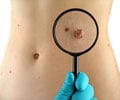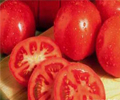Tomatoes contain compounds called carotenoids that play a vital role in reducing ultraviolet-induced skin cancer by half, finds a new study.
- Tomatoes have long been known for their skin-friendly properties
- A recent study has found that regular consumption of tomatoes can reduce the risk of skin cancer due to the carotenoids (pigment compounds present in tomatoes)
- Lycopene is an antioxidant in tomatoes that can reduce ultraviolet-induced skin cancer
How Tomatoes Reduce Skin Cancer Tumors
The research team conducted a study on mice to test how nutritional interventions can alter the risk of skin cancers. The team tested the dietary consumption of tangerine or red tomatoes as compared to a tomato-free diet, in reducing ultraviolet-induced tumor progression, after chronic ultraviolet exposure.For the study, the researchers fed the mice 10 percent of dehydrated tomato powder daily for 35 weeks. After exposure to ultraviolet light, only male mice experienced a 50 percent decrease in skin cancer tumors compared to mice that were not given dehydrated tomato powder. However, there were no significant differences in tumor development for the female mice in the study. Previously conducted studies have shown that male mice develop tumors earlier after UV exposure and their tumors are more numerous, larger and aggressive.
The study also found that only the male mice that were fed dehydrated red tomatoes had reductions in tumor growth. Mice that were fed diets with tangerine tomatoes had fewer tumors than the control group, but the difference was not statistically significant. Studies have shown that tangerine tomatoes are higher in bioavailable lycopene.
"This study showed us that we do need to consider sex when exploring different preventive strategies," said, Tatiana Oberyszyn, senior author of the study who is a professor of pathology and member of Ohio State's Comprehensive Cancer Center.
"What works in men may not always work equally well in women and vice versa," said Oberyszyn.
Cancer-Fighting Compounds in Tomatoes
The cancer-fighting properties of tomatoes are attributed to the presence of carotenoids, the pigment compounds that give tomatoes their color. Carotenoids protect the skin against UV light damage, said Jessica Cooperstone, co-author of the study and a research scientist in the Department of Food Science and Technology in the College of Food, Agricultural, and Environmental Sciences at Ohio State.Carotenoids act as a photoprotectants. Following the consumption of carotenoid-rich foods, these compounds are deposited on the skin to protect from UV damage.
The primary carotenoid in tomato is lycopene, which is the most effective antioxidant of these pigments. When comparing the administration of lycopene from tomato or a synthesized supplement, tomatoes are more effective in preventing redness after UV exposure. The findings suggest that other compounds in tomatoes may also play a role in preventing skin cancer.
"Alternative methods for systemic protection, possibly through nutritional interventions to modulate risk for skin-related diseases, could provide a significant benefit. Foods are not drugs, but they can possibly, over the lifetime of consumption, alter the development of certain diseases," said Cooperstone.
The findings of the study are published in the journal Scientific Reports.
Skin Cancer
Non-melanoma skin cancer is the most common of all cancer, with more new cases every year, according to the American Cancer Society. Though the mortality rate is low, skin cancers are disfiguring and their rates are increasing. The three main types of skin cancer are basal cell carcinoma, squamous cell carcinoma and melanoma. Non-melanoma skin cancers can be treated with topical medications or may require a simple surgery by a dermatologist.Reference:
- Jessica L. Cooperstone, Kathleen L. Tober, Ken M. Riedl, Matthew D. Teegarden, Morgan J. Cichon, David M. Francis, Steven J. Schwartz, Tatiana M. Oberyszyn. Tomatoes protect against development of UV-induced keratinocyte carcinoma via metabolomic alterations. Scientific Reports, (2017); 7 (1) DOI: 10.1038/s41598-017-05568-7















